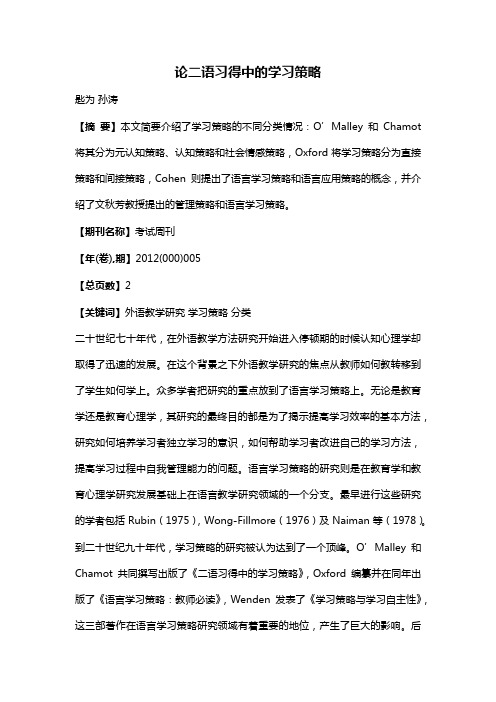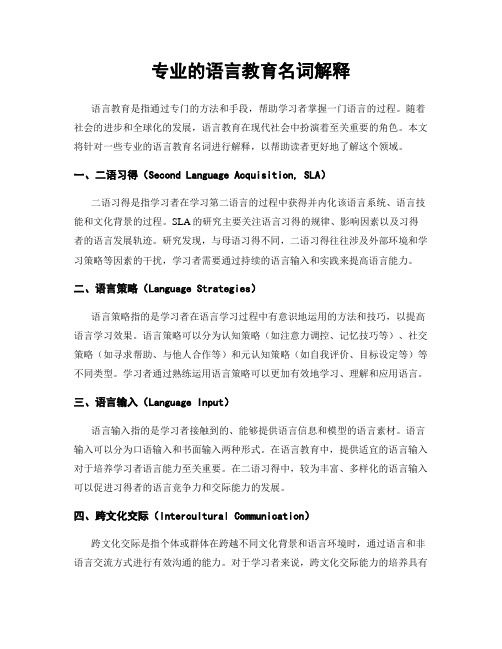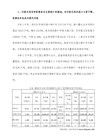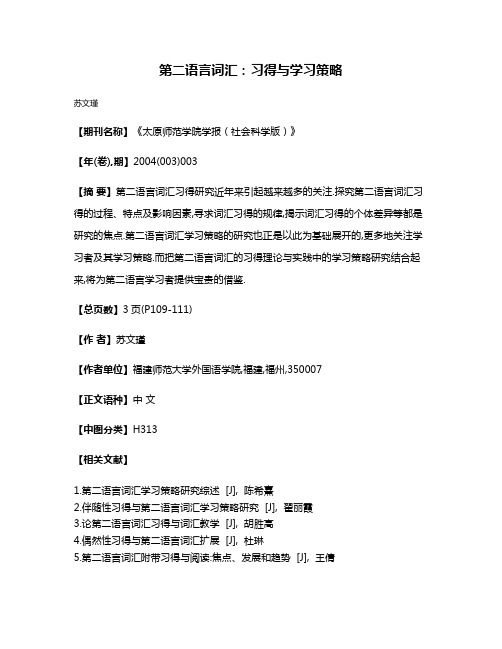二语习得(错误和学习策略) 剑桥大学出版社
《第二语言习得研究》重点知识点

《第二语言习得研究》重点知识点一、第二语言习得理论1.第二语言习得与第一语言习得的区别:第二语言习得是指学习者在已经掌握第一语言的基础上学习第二语言,与第一语言习得有所不同。
2.共同的习得条件:第二语言习得与第一语言习得都受到认知、社会、情感等多种因素的影响。
3.输入假设:学习者习得第二语言的过程中需要大量的输入来构建语言知识和语言能力。
二、第二语言习得过程1.初始期:学习者对第二语言的习得处于初始阶段,主要表现为对语言规则的不熟悉,需要借助外语教学材料和教师的指导。
2.中期:学习者开始积累语言知识,并能够进行简单的口语表达和书面表达,但仍然存在语法错误和用词不准确等问题。
3.发展期:学习者的语言技能和语言运用能力在这个阶段得到显著提高,能够流利地进行口语交流和书面表达。
4.准母语期:学习者的第二语言已经达到与母语相近的程度,几乎能够毫无困难地实现听、说、读、写等各方面的能力。
三、第二语言习得影响因素1.基础能力:个体的智力、工作记忆、认知能力等对第二语言习得有重要影响。
2.学习策略:学习者在习得第二语言过程中采取的方法和策略也对习得效果产生影响。
3.情感因素:学习者对学习第二语言的情感态度、自信心等情感因素对习得过程产生影响。
4.环境因素:学习者所处的学习环境,包括学校、家庭、社会环境等对第二语言习得有影响。
四、第二语言习得教学策略1.输出与输入平衡:教师应当提供足够的输入,同时鼓励学习者进行口语和书面的输出。
2.合作学习:通过合作学习,学习者能够在与他人进行互动中提高第二语言的流利度和准确度。
3.语境创设:教师可以通过创设各种真实的语言交际情境来提高学习者的第二语言习得效果。
4.个性化教学:教师应根据学习者的个体差异,采取不同的教学策略和方法,满足每个学习者的学习需求。
以上是《第二语言习得研究》的重点知识点。
了解这些知识点能够帮助我们更好地理解学习者在学习第二语言过程中的习得情况,并且在实际的第二语言教学中有所借鉴。
第五讲第二语言习得与学习策略PPT课件

两种语言习得都是为了培养言语交际能力。
(一)第一语言习得与第二语言习 得的相同之处:
两种语言习得都必须掌握语音、词汇、语 法等要素和受文化制约的语用规则,都必 须形成听说读写的技能。
第五讲:第二语言习得与学习策略
一、第一语言习得与第二语言学习对比 二、第二语言习得理论和假说 三、学习者的个体因素 四、语言学习环境
整体概述
概述一
点击此处输入
相关文本内容
概述二
点击此处输入
相关文本内容
概述三
点击此处输入
相关文本内容
一、第一语言习得与第二语言学习 对比
(一)第一语言习得与第二语言习得的相同 之处:
(二)第一语言习得与第二语言习 得的不同点
5、主体的生理、心理特点不同。
这是最基本的不同,是由儿童和成人的年 龄差异决定的。
可见,第一语言的习得过程伴随着学习者 人之常情、情感、生理等方面的发展变化, 而第二语言习得则是在上述变化基本完成 以后进行的。
二、第二语言习得理论和假说
第二语言习得研究的历史及范围的大概情况如 何?
(一)对比分析假说
拉多在上世纪50年代中期行为主义鼎盛时 期提出的。
1、第二语言的获得是通过刺激-反应-强化形 成习惯的结果。
2、正迁移与负迁移 3、只强调学习者通过刺激反应被动地养成一
定的语言习惯,否认学习者语言习得的认 知过程。忽视人的能动性和创造力。 4、是视听法和听说法的理论根据。
(二)中介语假说
造成过滤的是一些心理因素,如学习的动 力、对所学语言的态度、自信心、是否紧 张焦虑,是否处于防卫状态,怕出丑等。 这是对第二语言学习具有深远意义的假说。
论二语习得中的学习策略

论二语习得中的学习策略匙为孙涛【摘要】本文简要介绍了学习策略的不同分类情况:O’Malley和Chamot 将其分为元认知策略、认知策略和社会情感策略,Oxford将学习策略分为直接策略和间接策略,Cohen则提出了语言学习策略和语言应用策略的概念,并介绍了文秋芳教授提出的管理策略和语言学习策略。
【期刊名称】考试周刊【年(卷),期】2012(000)005【总页数】2【关键词】外语教学研究学习策略分类二十世纪七十年代,在外语教学方法研究开始进入停顿期的时候认知心理学却取得了迅速的发展。
在这个背景之下外语教学研究的焦点从教师如何教转移到了学生如何学上。
众多学者把研究的重点放到了语言学习策略上。
无论是教育学还是教育心理学,其研究的最终目的都是为了揭示提高学习效率的基本方法,研究如何培养学习者独立学习的意识,如何帮助学习者改进自己的学习方法,提高学习过程中自我管理能力的问题。
语言学习策略的研究则是在教育学和教育心理学研究发展基础上在语言教学研究领域的一个分支。
最早进行这些研究的学者包括Rubin(1975),Wong-Fillmore(1976)及Naiman等(1978)。
到二十世纪九十年代,学习策略的研究被认为达到了一个顶峰。
O’Malley和Chamot共同撰写出版了《二语习得中的学习策略》,Oxford编纂并在同年出版了《语言学习策略:教师必读》,Wenden发表了《学习策略与学习自主性》,这三部著作在语言学习策略研究领域有着重要的地位,产生了巨大的影响。
后来的众多研究者基本上都是按照这几位学者的研究思路进行研究的。
在中国文秋芳教授在这一领域的研究为语言学习策略理论框架的构建做出了重要贡献。
一1.O’Malley和Chamot的学习策略分类在《二语习得中的学习策略》中O’Malley和Chamot将学习策略分为:元认知策略、认知策略和社会情感策略。
元认知策略包括计划、监控、调节等具体方面,主要回答了语言学习中遇到的“何时做,如何做”等问题。
二语习得ppt课件

25
一、语言输入与语言形式调整的研究
(一)“外国人话语”的特点
“外国人话语”——指外国人的话语?(×) ——指对外国人说的话语。
Ferguson:“外国人话语”是指说某语言的人对该 语言能力有限者或者根本没有该语言能力者所使用 的一种简化的语体。 “外国人话语”与标准英语有三方面不用:
26
“外国人话语”与标准英语有三方面不用: 1.语音方面:语速慢、发音清楚、停顿、重音、夸
Hatch and Wagner-Gough,1976 Hatch ,1978a Peck,1978
早期关注是学习者的语言产出 语言输入与互动
5
研究材料来自母语者与学习者交流的转写材料,这些 材料使研究者不仅能观察到学习者的语言产出过程, 即学习者是怎么说的,同时也可以观察到母语者为学 习者提供语言输入的过程,即母语者对学习者是怎样 说的。
• 另一方面,外在的语言输入为学习者提供的仅仅 是关于目的语结构规则的“正面证据”( positive evidence),缺少“反面证据”( negative evidence)。
• 结果: 知道“怎样说”,不知道那些规则“不能 说”。
41
对“儿向语言”的研究
• 有学者发现:儿童的父母或保姆为儿童提供的都是符合规 则的话语,几乎很少纠正儿童的语法错误,为儿童提供不 合规则的反面证据。
例:你是哪国人? 你,哪个国家的?
教师语言:对外汉语教学课堂 例:请大家打开书。 书Book,打开Open
8
第二语言习得发展的重要影响
1、母语者与第二语言学习者交流使用的话语具有的“外国 人话语”“教师语言”特点,这种特定的语域风格的话语 为第二语言学习者提供了一个可理解输入环境。
二语习得书目

适合于初学者阅读书目:1.《二语习得引论》作者: 穆里埃尔·萨维尔·特罗伊克出版社: 外语教研出版年: 2008-12特点:《二语习得引论》是针对二语习得初学者的实用型入门教材,它介绍了二语习得的一些基本概念,回答了第二语言是如何习得的、学习者习得什么,以及为什么有些学习者比其他学习者更为成功等问题,同时鼓励学习者从语言学、心理学及社会学角度思考二语习得。
每章都包含重要术语列表、小结及供自测和课堂讨论的练习题。
《二语习得引论》适用于语言学、心理学及教育学的初学者及外语教师。
2.《二语习得重点问题研究》作者:文秋芳出版社:外语教学与研究出版社出版时间:2010-11-1特点:本书内容框架:第一章认知派与社会派论战20年第二章显性学习与隐性学习第三章语言输入、输出和互动第四章石化现象第五章语言迁移第六章自动性第七章年龄问题第八章社会文化理论本书针对二语习得领域中的要点、热点和富有争议的问题进行全面、深入的分析和评述。
全书共有八章,每章均以不同意见的争辩为组织内容的出发点,对相左的理论取向和不同的实证研究结果进行分析、梳理和评述,最后介绍或者展望国内外的最新发展趋势。
本书以“rerdders-friendly”为撰写原则,语言简洁明快,阐述深入浅出,易读易懂。
既可作为二语习得课程的教材,又是很好的参考资料,有助于二语习得领域的初学者了解二语习得的关键概念和研究问题,及该领域的学者和研究人员及时把握最新的学科动态,辨明理据,寻找焦点,确定选题。
适合研究型学者使用:3.《第二语言习得研究》作者: Rod Ellis出版社:上海外语教育出版社出版年: 1999-4-1特点:全书分7个部分。
第一部分是背景介绍,主要讨论第二语言习得的研究目标、研究内容和研究方法,并列出第二语言习得研究中存在的主要问题。
第二部分是对学习者语言的描述,主要从学习者的错误、语言习得的发展方式、学习者语言的可变性以及学习者语言的语用特征这四个方面对学习者语言的特点进行了描述,使读者了解习得第二语言的方式及过程。
二语习得知识梳理

Second Language Acqu isition /SLA第二语言习得(简称二语习得),通常指母语习得之后的任何其他语言学习。
人们从社会、心理、语言学等角度去研究它。
第二语言习得研究作为一个独立学科,大概形成于二十世纪60年代末70年代初,已有35年的历史。
它对学习者的第二语言特征及其发展变化、学习者学习第二外语时所具有的共同特征和个别差异进行描写,并分析影响二语习得的内部因素和外部因素。
与其他社会科学相比,二语习得研究是个新领域,大都借用母语研究、教育学研究或其他相关学科的方法。
概括地说,这一领域的研究是为了系统地探讨二语习得的本质和习得的过程,其主要目标是:描述学习者如何获得第二语言以及解释为什么学习者能够获得第二语言。
到目前为止,二语习得的研究范围远比20世纪七八十年代广,涉及语言学、心理学、心理语言学、语用学,社会语言学等众多方面。
早期的第二语言习得理论是教学法的附庸,为服务提高教学质量而存在,1967年Larry Selinke r在《语言迁移》这本专著第一次提出中介语理论,第二语言习得理论从此有了自己的研究领域而开始成为一门独立的学科。
现时的第二语言习得研究涉及三大领域,即中介语研究,学习者内部因素研究和学习者外部因素研究。
1994年美国费城Temple 大学教育学院二语英语教学教授Rod Ellis撰写巨著《第二语言习得研究》,成为该领域的经典教科书。
该书共分七个部分。
第一部分勾画了整本书的概念框架。
第二部分总结了有关学习者语言本质的主要理论,包括学习者错误,发展模式,语言变项和语用特征。
第三部分从外部因素解释第二语言的习得,主要阐述社会因素和输入/交互的作用。
第四部分从内部因素解释第二语言的习得,包括语言迁移、认知论解释和语言普遍性。
第五部分将讨论的重点从学习转移到学习者,论述了第二语言习得的个体差异和学习策略。
第六部分是关于课堂英语教学的论述,讨论了课堂交互和正规教学的有关理论。
《二语习得》课程教学大纲

【二语习得】课程(kèchéng)教学大纲【课程(kèchéng)代码】【课程(kèchéng)类别】专业(zhuānyè)任选课【学分】2【总学时】34【讲授(jiǎngshòu)学时】34【实验学时】【先修课程】《英语教师职业技能》【适用专业】英语专业师范方向高年级学生【教学目的】通过本课程的学习,要求学生了解第二语言(外语)习得的性质、特点、内容、理论研究流派、研究热点、教学原则、教学内容与方法等。
本课程采用多元视角,对二语习得与教学进行多学科、全方位的介绍与探讨,以便学生能够全面了解二语习得与教学全过程的诸方面,学习和研究二语习得与教学理论,从而加深对二语教学这一认知活动的理性认识,为进一步深入研究二语习得与教学打下基础,提高科研能力,提高运用理论探讨和解决英语教学问题的能力,力争成为积极、自觉的思考者和有独立解决问题能力的学习者、研究者。
【内容提要】第一章【语言、语言学习和语言教学】[基本要求] 了解语言教学中几个最基本的议题,即语言、语言学习和语言教学。
[重点难点] 使学生掌握语言学习和语言教学理论基础的全貌,并引导学生在此基础上,经过认真、审慎、理智、全面的思考,从中悟出自己的语言教学思路或理论。
[讲授学时] 2 学时第一节 [语言、学习与语言教学]语言学习与教学语言学与心理学的趋势第二节 [语言教学理论与方法]应用语言学语言教学理论(lǐlùn)与方法第二章【第一(dìyī)语言习得】[基本要求] 要求学生了解第一语言习得是认识第二语言学习原理的基础、掌握第一语言习得所涉及的主要议题、概念和主流理论(lǐlùn)观点。
[重点难点] 使学生意识到虽然本章议题都尚无定论,但第一语言(yǔyán)习得研究与第二语言习得研究关系密切相关,其导向和成果对第二语言习得研究(yánjiū)颇具启示。
二语习得中的错误分析理论及其在教学上的应用-6页word资料

二语习得中的错误分析理论及其在教学上的应用一、引言错误分析是第二语言习得(SLA)的重要研究方法之一。
第二语言习得过程是一个不断与语言错误斗争的过程。
学习者会在语言学习和操作中犯错误,语言教师在教学过程中不可避免地会遇到学生所犯的语言输出错误。
许多研究者在研究中发现,中国学习者的写作能力十分薄弱。
写作错误是语言输出中不可忽视的现象。
语言学界对待错误的态度经历了三个阶段,部分行为主义的学者认为,应该不惜一切代价纠正错误,结果有学者认为纠正错误增加了学习者的焦虑;赞同交际法的一些学者不主张纠正错误,渐渐发展到对错误的放纵,导致了石化现象(fossilization)产生;发展到最近才产生了对待错误的理性态度。
二、错误分析理论及其相关理论(一)对比分析(Contrasive Analysis)理论以行为主义者的语言学习理论为基础的对比分析理论在20 世纪五六十年代影响很大。
这一理论的含义是:首先,我们可以对学习者的母语(native language)和目的语(target language)进行对比;然后,根据对比分析中的差异,我们可以预测会引起困难的语言项目和可能犯的错误,并利用这些预测来决定外语课程和教材中哪些项目应进行特殊处理。
最后,我们可以利用强化手段(如重复和操练)来克服母语干扰,建立新习惯。
显然,该理论认为语言学习是个刺激―反应的过程,外语学习者在学习过程中犯错误是母语习惯负迁移(negative transfer)的结果,因此,为了强调学生学习语言的准确性,有必要对错误采取有错必纠的方针,以免学生形成错误的习惯。
(二)中介语(Interlanguage)理论应用语言学家Selinker 首先使用了中介语一词来称谓“学习者在目的语发展过程中的任何阶段所建造的一种结构体系”,是外语学习者“对目的语的规律所做的不正确的归纳与推论而产生的一个语言系统”。
它既不是母语,也不是目的语,而是学习者创造性地使用的一种语言。
专业的语言教育名词解释

专业的语言教育名词解释语言教育是指通过专门的方法和手段,帮助学习者掌握一门语言的过程。
随着社会的进步和全球化的发展,语言教育在现代社会中扮演着至关重要的角色。
本文将针对一些专业的语言教育名词进行解释,以帮助读者更好地了解这个领域。
一、二语习得(Second Language Acquisition, SLA)二语习得是指学习者在学习第二语言的过程中获得并内化该语言系统、语言技能和文化背景的过程。
SLA的研究主要关注语言习得的规律、影响因素以及习得者的语言发展轨迹。
研究发现,与母语习得不同,二语习得往往涉及外部环境和学习策略等因素的干扰,学习者需要通过持续的语言输入和实践来提高语言能力。
二、语言策略(Language Strategies)语言策略指的是学习者在语言学习过程中有意识地运用的方法和技巧,以提高语言学习效果。
语言策略可以分为认知策略(如注意力调控、记忆技巧等)、社交策略(如寻求帮助、与他人合作等)和元认知策略(如自我评价、目标设定等)等不同类型。
学习者通过熟练运用语言策略可以更加有效地学习、理解和应用语言。
三、语言输入(Language Input)语言输入指的是学习者接触到的、能够提供语言信息和模型的语言素材。
语言输入可以分为口语输入和书面输入两种形式。
在语言教育中,提供适宜的语言输入对于培养学习者语言能力至关重要。
在二语习得中,较为丰富、多样化的语言输入可以促进习得者的语言竞争力和交际能力的发展。
四、跨文化交际(Intercultural Communication)跨文化交际是指个体或群体在跨越不同文化背景和语言环境时,通过语言和非语言交流方式进行有效沟通的能力。
对于学习者来说,跨文化交际能力的培养具有重要意义。
它不仅能够有效改善个体的交际效果,还能够促进不同文化之间的理解和融合。
在语言教育中,跨文化交际也被视为一门重要的教育内容。
五、多语教育(Multilingual Education)多语教育是指在教育过程中,培养学习者同时掌握和使用多种语言的能力和意识。
《二语习得引论》第四章翻译报告

所以在报告的第三部分,译者通过对欧化现象在词汇层面和句子层面以及文化层 面的分析,以阐释学理论作指导,运用适当的翻译方法来解决翻译文本中的欧化 现象。在最后一个部分,译者总结了此次翻译的经验和教训,以及仍待解决的问 题,对翻译报告作出总结。
2原文背景
2原文背景
2.1作者简介
Introducing Second Language
Psychology of Second Language Acquisition)
进行翻译。本章是为语言学、心理学及教育学的初学者及外语教师详细介绍二语 习得的心理学原理。
本翻译报告主要由四部分组成。第一部分是对项目的背景和项目目标与意义 进行描述,并进一步阐述这篇翻译报告的结构;第二部分讨论了原文背景和作者 背景,分析原文的结构和语言特征。因为在翻译过程中,发现译文中出现了汉语 的欧化现象,所以在本报告的第三部分,译者通过对欧化现象在词汇层面和句子 层面以及文化层面的分析,以阐释学理论作指导,运用适当的翻译方法来解决翻 译文本中的欧化现象;在第四部分中,对翻译报告作出了总结。
本次翻译项目是对穆里埃尔・萨维尔・特罗伊克(Muriel Saville—Troike)的学 术著作《二语习得引论》(IntroducingSecondLanguageAcquisition)中的第四章(The
Psychology of Second Language
Acquisition)进行翻译,该书适用于初次接触第二
二语言习得,涉及到很多心理学、认知心理学的相关知识。 穆里埃尔・萨维尔・特罗伊克(Muriel Saville.Troike)的学术著作《二语习得 引论》(Introducing
Second Language
Acquisition)中的第四章(The
对外汉语《二语习得》题库及答案

对外汉语《二语习得》题库及答案第一章单元测试1、判断题:习得与学习二者之间的关系是割裂的。
()选项:A:对B:错答案: 【错】2、单选题:最早发现习得与学习存在区别的是语言学家()选项:A:乔姆斯基B:斯蒂芬?克拉申C:洪堡特D:斯韦恩答案: 【斯蒂芬?克拉申】3、多选题:关于习得与学习的关系,下列说法正确的是()选项:A:可以用两个三角形表示;B:这两个三角形是倒置的;C:这两个三角形是部分交叠的;D:这两个三角形是完全重叠的。
答案: 【可以用两个三角形表示;;这两个三角形是倒置的;;这两个三角形是部分交叠的;】成人完全可以做到和儿童一样习得外语。
()选项:A:对B:错答案: 【错】5、判断题:儿童习得外语的能力总体上高于成人。
()选项:A:对B:错答案: 【对】6、判断题:传统语言课堂收到的质疑越来越多,我们应该遵循习得规律,改革创新教学模式和方法。
()选项:A:对B:错答案: 【对】7、判断题:最早获得的语言一定是最熟悉的。
()选项:A:对B:错答案: 【错】一个在外国出生的华裔儿童,他最早接触的是汉语,成长过程中主要说英语,那么,下列说法正确的是()选项:A:他的母语是汉语;B:他的第一语言是汉语;C:他的第二语言是英语;D:他的母语是英语。
答案: 【他的母语是汉语;;他的第一语言是汉语;;他的第二语言是英语;】9、多选题:一个在外国出生的华裔儿童,他成长过程中只接触和说英语,那么,下列说法正确的是()选项:A:他的母语是英语;B:他的第一语言是英语;C:他没有外语;D:他的外语是英语。
答案: 【他的母语是英语;;他的第一语言是英语;;他没有外语;】10、判断题:第一语言是语言学的概念,母语更多的牵涉到民族学问题。
()选项:A:对B:错答案: 【对】11、判断题:语言学多是理论研究,心理学、心理语言学等多是实验研究。
()选项:A:对B:错答案: 【对】第二章单元测试1、多选题:关于大脑和语言习得,行为主义心理学派有两个非常著名的观点,分别是()。
二语习得研究热点综述

校园英语 / 语言文化二语习得研究热点综述山东师范大学外国语学院/张天凝【摘要】本文着重介绍国外二语习得研究的最新动态,并总结最近二语习得的发展特点,并探寻与确定研究方向。
【关键词】二语习得 研究热点一、二语习得研究热点社会派阵营于上个世纪80年代中期初步形成。
他们的理论背景比较复杂,有的受苏联维果斯基(Vygotsky)的社会文化理论(Sociocultual Theory)的影响,有的基于会话分析理论(Conversation Analysis Theory),有的信奉社会化理论(Language Socialization Theory),有的相信后结构主义(poststructralism),有的以巴赫金的对话主义(dialogism)为基础(Swain&Deters,2007)。
2007年12月,《现代语言》杂志组织了两派辩论。
Larsen-Freeman根据学者对待Firth&Wagner1997年文章的看法,将他们分为三种情况:坚决支持;部分支持;坚决反对。
进入 90 年代以来,有关普遍语法的争论从广义的可及性问题转向了中介语表征性质的具体探讨。
在中介语表征初始状态问题上出现了两种观点:以Schwartz和Sprouse(1996)为代表的完全迁移假设(the Full Transfer Hypothesis)认为,中介语表征符合自然语言的特征;而以Vainikka和代表Young-Scholten(1996)为代表的最简述假设(the Minimal Trees Hypothesis)则认为,中介语表征在某些基本方面不同于自然语言。
对学习者内部因素的研究主要围绕学习者的个体差异,如语言学能、动机、认知风格等,这类研究强调学习主体在二语习得过程中的作用。
Ellis(1994)提出了个体差异研究的理论框架,该框架由三组相互联系和相互影响的变量构成:个体差异→学习者策略→语言学习效果。
前辈的二语习得

二语习得(一) Learner Strategies1. Learning Strategies学习策略Nowadays, LLSs are mainly divided into three major categories on the basis of level or type of processing involved: cognitive, metacognitive, and social/affective strategies (Brown & Palinscar, 1982; Chamot &O‟Malley, 1990; O‟Malley et al., 1985; Rubin, 1981).(1) Cognitive Learning Strategies认知学习策略Early focus of language learning strategies was mostly placed on cognitive skills. Cognitive learning strategies refer to the learning strategies that directly affect the learner‟s language learning. They “operate directly on incoming information, manipulating it in ways that enhance learning” (Chamot & O‟Malley, 1990, p. 44). Oxford (1990) used the term “direct strategies” and Dansereau (1985) used “primary strategies” to refer to the cognitive strategies. Rubin (1981) also made a distinction between “direct processes” and “indirect process,” similar to the divisions made by Oxford (1990). The direct processes referred to the cognitive strategies, and the indirect processes indicated the other two strategies, metacognitive and affective/social strategies.Cognitive strategies are also more directly related to a specific task ora learning objective and may not be applicable to different types of tasks. The focus of cognitive strategies is on determining the effect of different cognitive strategy training on different kinds of tasks and learners.Classfication of cognitive strategies认知学习策略的分类:Different experts have classified cognitive strategies differently.a. Mayer and Weinstein (1986) proposed that cognitive strategies could be summed into three categories: rehearsal, organization, and elaboration process.b. Chamot and O‟Malley suggested that typical cognitive strategies included rehearsal, organization, inference, summarizing, deduction, imagery, transfer, and elaboration.c. In Oxford‟s view (1990), the direct strategies comprised m emory, cognitive, and compensation strategies, each of which was further subcategorized in Oxford's work.(2) Metacognitive Learning Strategies 元认知学习策略Metacognitive strategies refer to the “overall control over the learning process through reasoning, planning, monitoring, andself-evaluation”. They are knowledge and regulation about cognitive phenomena; the knowledge enables individuals to “plan, sequence, and monitor their learning in a way that directly improves performance” .Metacognitive strategies, unlike the confinement of cognitivestrategies, are more universal among various tasks. The strategies are deemed as the highest superiority.Classfication of Metacognitive Learning Strategies元认知学习策略的分类:a. Oxford (1990) pointed out three sub-strategies for metacognitive strategies: centering your learning, arranging and planning your learning, and evaluating your learning.b. Anderson (1991) subsumed these strategies into five steps: preparing and planning for effective learning, selecting and using particular strategies, knowing how to monitor strategy use, learning how to orchestrate various strategies, and evaluating strategy use and learning.c. According to Brown and Palincsar (1982), these strategies involved reflecting, planning, and monitoring in the process of learning as well as self-evaluation after the learning activities.(3) Social/affective strategies社会/情感策略Social/affective strategies refer to strategies involving the interaction with other people or the management of affect. Like metacognitive strategies, they are thought to be more applicable to various tasks (Chamot & O‟Malley, 1990).Social strategies are those activities affording learners “opportunities to be exposed to and practice their knowledge” (Rubin, 1987, p. 27).Affective strategies are “the ways in which learners deal with their affect and emotional states” (Liu, 1996, p. 21).To sum up, social strategies promote the practice opportunities and affective strategies help learners take care of the emotions; both of the strategies affect the learning effect.subcategories for affective/social strategies: 社会情感策略的分类a. Chamot and O‟Malley (1990) recognized three affective/social strategies: cooperation, questions for clarification, and self-talks.b. Oxford (1990), otherwise, gave some more detailed items: lowering your anxiety, encouraging yourself, and taking your emotional temperature for affective strategies; and asking question, cooperating with others, and empathizing with others for social strategies.Strategy Learning and Instruction学习策略的训练In spite of the fact that learners are endowed with some learning strategies, learners, in general, have difficulties recognizing related learning strategies in the real application. They need training in the choice and application of learning strategies. Teachers also have to invest time in the instruction of learning strategies.The Instruction Method 训练方法(1) direct instruction 直接训练Some scholars advocated direct instruction. With this approach, learners are explicitly informed of the purpose and significance of the instructed strategies. Instruction is given to learners on the regulation and monitoring of strategies.Wenden (1987a) also proposed that learners also had to be informed explicitly of the anticipated effects of the practiced strategies to remain their interest in sticking to strategy use. This method is deemed beneficial in maintaining the strategy use over time and in transferring strategies to new tasks.(2) embedded instruction嵌入式训练also named as integrated, content-dependent, implicit, unconscious, and so on.For this method, strategies are not taught explicitly to learners; they are integrated into the context. Advocates of this kind of instruction assumed that learning in context was more effective and that it facilitated the transfer off strategies to similar tasks.According to Chamot and O'Malley (1990), many experts favor the direct instruction. The characteristics of the direct strategy instruction mentioned in Chamot and O'Malley's work were arranged into the following principles:a. Learners have to be conscious of strategy instruction. Learners willnever know about the strategy use if not informed.b. The class is well-planned, and short programs of a detached strategy training are required.c. The activities are built upon prior knowledge and are executed through cued practice.d. Strategies are flexible; different strategies are applied in different tasks. The purpose and the strategy application need to be stated.e. The development in teachers themselves of the comprehension of the importance, the related rationale, and the techniques for effective strategy training is required.f. The development and adaptation of instructional materials are required.Practice of Strategy Instruction 策略训练的实践(1) Preparation: explaining to students the purpose and utility of learning strategies in general.(2) Presentation: modeling the way of using the learning strategies to students.(3) Practice: providing students with repeated opportunities to practice the new strategies.(4) Evaluation: instructing students how to evaluate their own strategy use.(5) Expansion activities: discussing the strategy use and its future application.2. Production Strategies 输出策略Three programms of production 输出的三个阶段(1) Planning Program计划阶段: communicative goal--discourse plan--sentence plan--constituent plans(2) Articulatory Program表达阶段: meaning selection--syntactic outline--content word selection--affix and function wordformation--specification of phonetic segments(3) Motor ProgramCategories of production strategies输出策略的分类Planning strategies(1) Semantic simplication语义简化Semantic simplication occurs when the learner simplifies the sentence plan by reducing the propositional elements that are linguistically coded.E.g. He is hitting me.The learner may produce any one of the following abridged versions:Hitting. He hitting. Hitting me.(2) Linguistic simplication 语言简化Linguistic simplication involves the omission of form words and affixes. The learner may produce an utterance like: He hitting me.Semantic simplication and linguistic simplication are 'minimal strategies' used to facilitate easy and effective use of the L2 system. They are the procedures used by the learner in the early stage of SLA when he has minimal L2 resources and needs to employ them in a maximally easy and effective manner.Correcting strategies: monitoring 监控策略Krashen argues that the learner possesses two kinds of knowledge, which are implicit or intuitive knowledge, and explicit or metalinguistic knowledge. According to Krashen, the learner initiates utterances using only implicit knowledge, but is able to Monitor his performance using explicit knowledge either before or after articulation.3. Communication Strategies交际策略Strategies for using L2 knowledge. These are used when learners do not have the correct language for the concept they wish to express. Thus they use strategies such as paraphrase and mime.Communication strategies serve to:steer conversation away from problematic areas,express meaning in creative ways (e.g., by paraphrasing aword/concept),create more time to think (e.g., by using fillers or other hesitation devices),negotiate the difficult parts of the communication until everything is clearExamples include: use of synonyms, use of cognates (whether equivalent in meaning or not), use of simple sentences, use of semantic contiguity (i.e., nearest, the use of word …chair‟ for …stool‟), use of gestures or mime, and use of circumlocution or paraphrase (Tarone, 1977; Rubin 1981).。
第二语言习得课程讲义

第二语言习得课程讲义任课教师:张景华聊城大学外国语学院第一节语言1、语言的定义及性质2、第一语言与母语3、第二语言与外语4、语言与言语5、语言与社会6、语言与思维7、语言与文化、跨文化(文化:1)生态文化(ecological culture);2)语言文化(linguistic culture);3)宗教文化(religious culture);4)物质文化(material culture);5)社会文化(social culture).跨文化:阅读下面短文,思考这些女生犯了什么错误?What is Wrong with Their “Hello”?A group of Chinese girls who just arrived at the <st1:country-region w:st="on">United States for their university education decided to visit the city of New York together. Since their school was not very far from the city, they planned to take a Greyhound bus(“灰狗”,美国一长途汽车公司名)to go there at weekend. Saturday morning, they got up early and after two hours’drive they got to the downtown of the city. They stayed there for a couple of hours, shopping and sightseeing happily. Everything seemed OK until it was the time for them to go back----they suddenly realized that they lost their way back to the Greyhound bus station. What made the situation worse was that it was getting darker. In despair, they stopped at a corner on the street and decided to ask for help. At this moment they saw a young couple passing by, so they said “Hello!” to this couple. To their surprise, the couple looked at them coldly and hustled on. Having no way out, they approached to th e next group of passerby and tried a louder “Hello!” this time. Again they got nothing but a cold shoulder from these city people.显而易见,细心的读者已经知道这些女生的错误所在了——不是语言错误,而是语用错误。
《第二语言习得研究》全书概要 (知识点全)

《第二语言习得研究》全书概要第一章绪论第一节第二语言习得的一般概念第二语言习得(second language acquisition),简称SLA,是指人们在获得母语(第一语言)的基础上习得另一种或几种语言的过程。
也叫“二语习得”。
一、母语与目的语母语指学习者所属种族、社团使用的语言,也称作“本族语”。
目的语,也叫目标语,一般指学习者正在学习的语言。
二、第一语言与第二语言第一语言指儿童幼年最先接触和习得的语言,在此后习得的语言就是第二语言。
三、习得与学习克拉申(Krashen)认为成人L2学习者有两种独立的语言获得方式,两者在获得方式、心理过程、所获得的知识类型、作用等方面都不同Krashen认为,习得的知识与学得的知识是相互独立的两种知识。
学得的知识无法转换成习得的知识。
即所谓“无接口观点”(non-interface position)。
自然习得研究的证据表明,在习得情况下并未发生学习的过程,有时候,学习者可以先学会某个规则,但是并没有习得这个规则。
也就是说学习过程并不一定导致习得过程的发生。
无接口观点的证据:Seliger(1979)的证据:他让在课堂上让学习者描述一些图片,然后分析这些学习者使用冠词a与an的情况;此外,他让这些学习者陈述关于冠词用法的相关规则。
调查分析表明,学习者的实际语言表达与其元语言知识不相关。
也就是说,“习得”与“学习”的确是彼此独立的。
第二语言习得是指学习者在目的语国家学习目的语。
外语习得指学习者所学的语言在本国不是作为整个社团的交际工具,而且学习者所学的语言主要是在课堂上学习的。
五、自然的第二语言习得与有指导的第二语言习得:前者指在自然的社会环境下以交际的方式获得第二语言;后者指在课堂教学环境中以教学指导的方式获得第二语言。
语言能力是一种反映交际双方语言知识的心理语法。
语言表达指交际双方在语言的理解与生成过程中对其内在语法的运用。
一、第二语言习得研究与语言学:语言学是一个古老的学科,第二语言习得研究则是一个年轻的学科。
第二语言词汇:习得与学习策略

第二语言词汇:习得与学习策略
苏文瑾
【期刊名称】《太原师范学院学报(社会科学版)》
【年(卷),期】2004(003)003
【摘要】第二语言词汇习得研究近年来引起越来越多的关注.探究第二语言词汇习得的过程、特点及影响因素,寻求词汇习得的规律,揭示词汇习得的个体差异等都是研究的焦点.第二语言词汇学习策略的研究也正是以此为基础展开的,更多地关注学习者及其学习策略.而把第二语言词汇的习得理论与实践中的学习策略研究结合起来,将为第二语言学习者提供宝贵的借鉴.
【总页数】3页(P109-111)
【作者】苏文瑾
【作者单位】福建师范大学外国语学院,福建,福州,350007
【正文语种】中文
【中图分类】H313
【相关文献】
1.第二语言词汇学习策略研究综述 [J], 陈希熹
2.伴随性习得与第二语言词汇学习策略研究 [J], 翟丽霞
3.论第二语言词汇习得与词汇教学 [J], 胡胜高
4.偶然性习得与第二语言词汇扩展 [J], 杜琳
5.第二语言词汇附带习得与阅读:焦点、发展和趋势 [J], 王倩
因版权原因,仅展示原文概要,查看原文内容请购买。
中国英语教学的20个神话

中国英语教学的20个神话英语教师认为可能正确的神话,或者是比较流行的理念和教法,有些甚至是写入文件的,都属于外语教学中的学术专业问题,可能是教学误区。
这样的神话类问题很多,大概有五十个左右。
我剖析其中主要的20个神话,因为这些神话都影响到我国现在的课程理念和英语教学。
第一,核心素养和四维目标(Key Competences & 4 Dimension Objectives)。
我不是反对核心素养和四维目标,但是持质疑态度,因为核心素养的概念翻译有问题。
key competence译成中文,不能翻译成“核心素养”,只能译为“关键能力”,因为competence半个世纪以来一直就是“能力”的含义,是很多知识、很多技能和很多能力构成的更高的能力,不能翻译成“素养”。
欧盟对此也有一些说法,他们提到的key competences是可以操作和执行的,即培养什么样的人才。
而我国《普通高中英语课程标准》中提到的说法都是抽象的概念,假、大、空,和语言学习关系不大,是无法测量和培养的。
核心素养下的外语教学目标不是学习语言,越来越淡化语言知识和语言技能,目前到了3.0或4.0版,就是说外语教学目标变成了四维目标,到底哪个是主要的,哪个在先哪个在后,谁也说不清楚。
目标本来应该是很明确的东西,这样才可以利于落实和达成。
第二,二语习得(SLA)。
在中国,英语是外语教学(FL),自然习得不了英语。
二语习得强调无意识学习,没有计划的学习。
学生学习英语,没有环境(context),没有时间的可承受度(affordance),不能自然习得。
即使是习得,想要建构知识,必须首先要解构知识。
先有概念性知识,才能输入、接收、储存、加工、内化,之后才能输出和使用。
顺序还是先学习知识。
所以,二语习得理念不适合我国学情和教情。
第三,任务型教学(TBLT)。
2005年任务型教学在国际上已经在行业内被彻底批判,但也是在这之后被引进到中国。
印度班加罗尔搞了一个实验,但并没有成功。
- 1、下载文档前请自行甄别文档内容的完整性,平台不提供额外的编辑、内容补充、找答案等附加服务。
- 2、"仅部分预览"的文档,不可在线预览部分如存在完整性等问题,可反馈申请退款(可完整预览的文档不适用该条件!)。
- 3、如文档侵犯您的权益,请联系客服反馈,我们会尽快为您处理(人工客服工作时间:9:00-18:30)。
Transfer
Overgeneralisation Redundancy reduction
Transfer and overgeneralization are expressions of the same underlying strategy of using previous knowledge to understand new experience.
Functions: Through overgenralisation and transfer, the confusing variety of linguistic data is made more manageable, by fitting it into a framework of categories and rules that the learning already possesses. Features: Simple to manage and more productive.
Three processes work together and reinforce each other
Redundancy reduction can coincide(相符)with transfer and overgeneralisation
The differences among three learning processes:
② Redundancy Reduction Introduction: This is the kind of simplification which we saw in children’s telegraphic speech. The omission of inflections and other morphemes seems to be due more to limitations in capacity than to the construction of rules. It is sometimes called ‘redundancy reduction’. It eliminates many items which are redundancy to conveying the intended message. Examples: Daddy want chair.(The omission of the verb inflection and article doesn’t prevent the meaning from being understood.) Party hat.(A party hat) Cup glass(Cup and glass) Feature: Less productive Tips: Dedundancy reduction makes production easier but may, of course, make comprehension difficult or even impossible.
3 Errors and learning strategies (3.5 —3.8)
3.5 Simplification by omission What are forms of simplification?
①Overgeneralisation and Transfer They can both be seen as expressions of the same underlying strategy of applying previous knowledge to the second language learning task. They can also both be seen as forms of simplification.
Conclusion: Different processes overlap(重叠)and may work together. There are cases when it is not possible to distinguish between redundancy reduction due to omission and the effects of overgeneralization, which may be the same.
The main creative processes: Transfer and Generalisation The less directly creative processes: Simplification through omission.
③ Redundancy reduction by omitting elements.
The first one is an ‘interlingual’ process. The second and third are ‘intralingual’ process
Simplification
3.6 Learning processes: summary
What Leabharlann re learning processes ?
① Transfer of rules from the mother tongue. ② Generalisation (and overgeneralization) of second language rules.
For example, the verb form in He go for caféof He understand chess can be seen both as redundancy reduction by omitting the third-person ending, and as overgeneralization of the form used after I, we, and so on.
